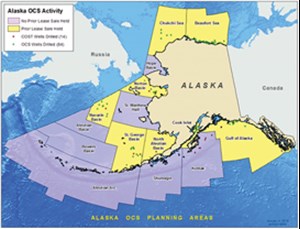Offshore in Depth
While Alaska is an important energy state, it is not a major offshore oil producer. In 2016, production from the Cook Inlet totaled around 5.7 MMbbl and 296 Bcfg, compared to 183 MMbbl of oil from the North Slope. Still, when Interior Secretary Ryan Zinke announced BOEM’s 2019–2024 proposed leasing program for the OCS on Jan. 4, Alaska’s response reflected the contradictions of the nation’s discussion about offshore exploration and development.
The proposal called for 19 lease sales in 15 planning areas, including 1.035 billion acres, or 90% of the waters surrounding Alaska, Fig. 1. The only area not included was Bristol Bay, immediately north of the Aleutian Peninsula, which is the most active region for the Alaskan fishing industry. Native residents along the north coast would benefit from employment opportunities and investment to support offshore activity.
Praise, then reservations. The initial response from Alaska’s elected officials was positive. Sen. Lisa Murkowski (R-Alaska), who traded her vote for the tax bill for a provision opening the Arctic National Wildlife Reserve (ANWR) to limited drilling, initially praised the draft plan. Gov. Bill Walker (I-Alaska) called it “an important step toward allowing Alaskans to responsibly develop our natural resources.” But then they heard from their constituents, including commercial fishermen and native people, who depend on the marine environment for their livelihoods. A fishing industry representative pointed out that more than half the U.S. domestic seafood comes from Alaska, and the industry provides many thousands of jobs. Remote native communities rely on subsistence fishing.
By Jan. 30, the governor and the Republican congressional delegation asked Interior to drop plans for offshore leasing in 12 of the 15 Alaskan planning areas, while going forward with lease sales in the Cook Inlet and the Chukchi and Beaufort Seas. This would reset access to Alaska’s offshore, to areas that were open before the moratorium mandated by the Obama administration. The three areas in question are the only ones with recent drilling activity, and according to BOEM estimates, they are the only Alaskan planning areas with significant unleased, undiscovered, economically recoverable reserves (UERR). If oil prices reached $100/bbl, BOEM estimates for economically developable resources dictate that the Chukchi Sea has 13.27 Bboe, the Beaufort Sea has 7.5 Bboe and federal waters in the Cook Inlet hold 1.12 Bboe of UERR.
The operators of the Trans Alaska Pipeline System would like more development in the Chukchi and Beaufort areas to increase throughput, which is now at 25% of the pipeline’s capacity.
Limited offshore success. Successful offshore drilling in Alaska has been limited to the Cook Inlet, where oil was discovered in the early 1960s, and 17 platforms now operate in state waters. Operators have drilled 13 exploratory wells on Cook Inlet federal leases without commercial finds. Fourteen leases are still held by oil companies.
Since the 1970s, a total of 36 dry exploration wells have been drilled in the Norton, Navarin and St. George basins off Alaska’s northwest coast, and there are no remaining leaseholders. Operators drilled 12 exploration wells in the Gulf of Alaska off the southeastern part of the state from 1976 to 1981. These efforts demonstrated the ability to operate in difficult conditions, but did not make a commercial discovery.
Tantalizing reserve potential. The potential reserves in the Chukchi and Beaufort Sea areas off the far north coast have tantalized operators since 2008. In this decade, Shell made two major efforts to drill in the Chukchi Sea. A 2012 campaign ended with grounding of the Kulluk drilling barge. In 2015, Shell deployed two floating rigs, an ice breaker with a capping stack; a containment dome; and about 30 other vessels to support the operation and respond to any emergencies, all to drill one unsuccessful well.
Last year, Eni was granted a permit to drill two exploration wells and two sidetracks from the Spy artificial island 3 mi out in the Beaufort Sea, where 18 wells are already producing. Eni plans to test formations under federal waters in Harrison Bay Block 6423 from the only rig active in the Beaufort Sea area. The first well was spudded in late December and drilling will continue through May.
Uncertain future. It remains to be seen whether the industry will invest in further offshore exploration in the Arctic. Although crude prices have recovered, sustained $100/bbl oil is not in the foreseeable future. However, drilling in ANWR may be a less risky proposition. Lease sales for the Beaufort and Chukchi areas in 2015 were canceled for lack of interest, and operators have relinquished 487 Chukchi leases that they had purchased for a combined $2.8 billion.
The Juneau Empire newspaper summed up the uncertain future of Alaska’s offshore development in a Jan. 5 headline which read in part: “Drill, maybe drill.” ![]()

- Advancing offshore decarbonization through electrification of FPSOs (March 2024)
- Subsea technology- Corrosion monitoring: From failure to success (February 2024)
- Prices and governmental policies combine to stymie Canadian upstream growth (February 2024)
- Driving MPD adoption with performance-enhancing technologies (January 2024)
- Digital transformation: A breakthrough year for digitalization in the offshore sector (January 2024)
- Offshore technology: Platform design: Is the next generation of offshore platforms changing offshore energy? (December 2023)
- Applying ultra-deep LWD resistivity technology successfully in a SAGD operation (May 2019)
- Adoption of wireless intelligent completions advances (May 2019)
- Majors double down as takeaway crunch eases (April 2019)
- What’s new in well logging and formation evaluation (April 2019)
- Qualification of a 20,000-psi subsea BOP: A collaborative approach (February 2019)
- ConocoPhillips’ Greg Leveille sees rapid trajectory of technical advancement continuing (February 2019)



